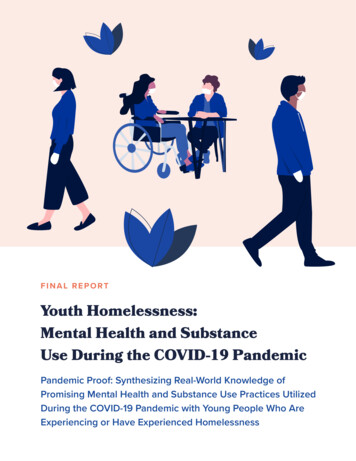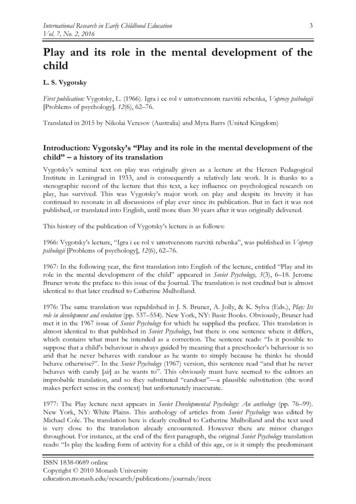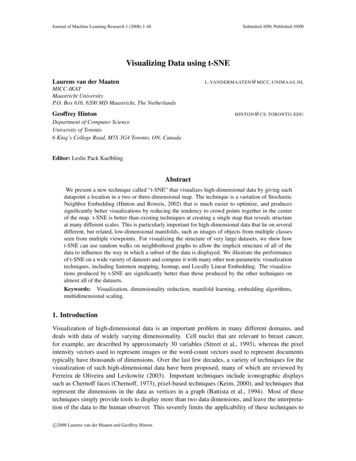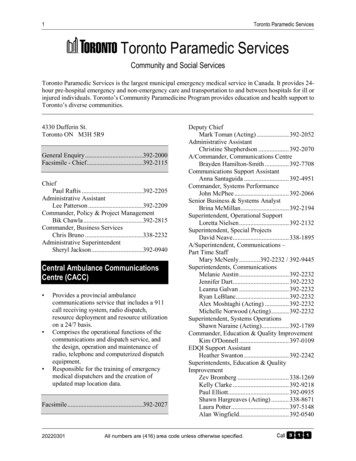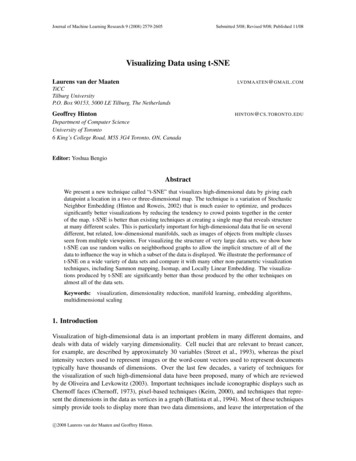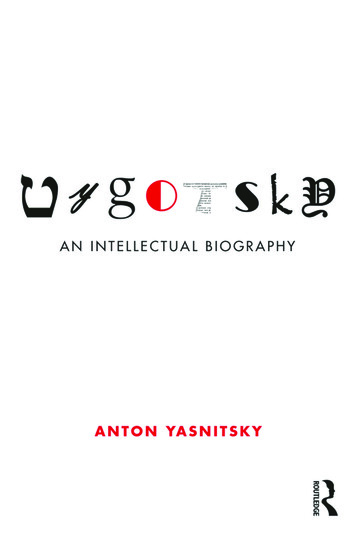
Transcription
VYGOTSKY– The most famous Russian psychologist, whose life and ideas are least known?– A pioneer of psychology who said virtually nothing new?– A simple man who became a genius after he died?This fundamentally novel intellectual biography offers a 21st-century account ofthe life and times of Lev Vygotsky, who has long been considered a pioneer in thefield of learning and human development. The diverse Vygotskian literature hascreated many distinct images of this influential scientist, which has led manyresearchers to attempt to unearth ‘the real Vygotsky’. Rather than join this quest toover-simplify Vygotsky’s legacy, this book attempts to understand the developmentof ‘the multiple Vygotskies’ by exploring a number of personae that Vygotskyassumed at different periods of his life. Based on the most recent archival, textologicaland historical investigations in original, uncensored Russian, the author presents aground-breaking account that is far from the shiny success story that is typicallyassociated with ‘the cult of Vygotsky’.This book will be an essential contribution to Vygotskian scholarship and ofinterest to advanced students and researchers in history of psychology, history ofscience, Soviet/Russian history, philosophical psychology, and philosophy of science.Anton Yasnitsky, Ph.D., is an independent researcher who specializes in theVygotsky-Luria Circle. He has coedited (with René van der Veer et al.) TheCambridge Handbook of Cultural-Historical Psychology (2014), Revisionist Revolution inVygotsky Studies (2015), and Vygotski revisitado: una historia crítica de su contexto ylegado (2016).
This page intentionally left blank
VYGOTSKYAn Intellectual BiographyAnton Yasnitsky
First published 2018by Routledge2 Park Square, Milton Park, Abingdon, Oxon OX14 4RNand by Routledge711 Third Avenue, New York, NY 10017Routledge is an imprint of the Taylor & Francis Group, an informa business 2018 Anton YasnitskyThe right of Anton Yasnitsky to be identified as author of this work has beenasserted by him in accordance with sections 77 and 78 of the Copyright, Designsand Patents Act 1988.All rights reserved. No part of this book may be reprinted or reproduced orutilised in any form or by any electronic, mechanical, or other means, nowknown or hereafter invented, including photocopying and recording, or in anyinformation storage or retrieval system, without permission in writing from thepublishers.Trademark notice: Product or corporate names may be trademarks or registeredtrademarks, and are used only for identification and explanation without intent toinfringe.British Library Cataloguing in Publication DataA catalogue record for this book is available from the British LibraryLibrary of Congress Cataloging in Publication DataNames: Yasnitsky, Anton, 1972- author.Title: Vygotsky : an intellectual biography / Anton Yasnitsky.Description: Abingdon, Oxon ; New York, NY : Routledge, 2018. Includesbibliographical references and index.Identifiers: LCCN 2018004725 ISBN 9781138806733 (hbk : alk. paper) ISBN 9781138806740 (pbk : alk. paper) ISBN 9781315751504 (ebk)Subjects: LCSH: Vygotskiæi, L. S. (Lev Semenovich), 1896-1934. Psychologists--Soviet Union.Classification: LCC BF109.V95 Y373 2018 DDC 150.92 [B] --dc23LC record available at https://lccn.loc.gov/2018004725ISBN: 978-1-138-80673-3 (hbk)ISBN: 978-1-138-80674-0 (pbk)ISBN: 978-1-315-75150-4 (ebk)Typeset in Bemboby Taylor & Francis Books
CONTENTSCover legendOuvertureixxi1ProphetThe Gomel years (1896–1913) 1A Jew admitted to the Imperial Moscow University 3Literary criticism (1914–1916) 5Beba Vygodskii: the “young Jewish prophet” 6The Russian Revolution (1917–1918) 9Lev Vygodskii during the Russian Revolution 11The First World War (1914–1918) and its aftermath 12In Ukrainian Gomel in 1918 1312BolshevikGomel during the Russian Civil War 17The “cultural front”, Marxism, and the “new man” 18Lev Vygotsky in Gomel in 1919–1921 23New Economic Policy (NEP) and the birth of the Soviet Union 25Vygotsky as a publisher, political activist, and theatrical critic(1922–1923) 27173ReflexologistVygotsky teaches and lectures 31Vygotsky’s entrance into psychology 32Teaching about reflexes: Pavlov’s and Bekhterev’s research methods 34Vygotsky’s new method: “Double Stimulation” 37Vygotsky and reflexology 40Second Psychoneurological Congress as a landmark 4131
vi Contents4PsychologistAlexander Luria: Vygotsky’s alter ego 43Vygotsky’s return to Moscow 44Marxist practicality and the “new science” 48The variety of “new psychologies” 49The trip to London and its aftermath 52Vygotsky’s three books 54Psychology as a science about the superman 57The Vygotsky–Luria Circle: people and institutes 62“Instrumental Psychology” 65Unexpected discoveries: word meaning, dialogue, and inner speech 69The outcomes of the 1920s 73435RevisionistStalin’s Great Break and the Cultural Revolution 79Vygotsky’s life and career at the turn of the decade 81Ninth International Psychological Congress and its impact 82Towards a new psychological theory 83The demise of “reactology” 87Criticizing Vygotsky 90Vygotsky criticizes Vygotsky 94Expeditions to Central Asia in 1931 and 1932 95Revisionist conclusion 101796HolistThe challenge of totality: holistic Gestalt psychology 106Kurt Lewin’s “Galileian” psychology 110The Vygotsky–Luria Circle in the 1930s 113Major theoretical reconstruction and new experimentation 115“The threshold of a new theory”: the pessimistic finale 118106Epilogue. Genius122Timeline of landmark eventsGlossaryConventions and acknowledgementsBibliographyIndex127131133135147
Только змеи сбрасывают кожи,Чтоб душа старела и росла.Мы, увы, со змеями не схожи,Мы меняем души, не тела.Николай ГумилевOnly serpents shed their skins foreverSo that their souls would age and grow.We are not like serpents, all that clever,We change not our bodies, but our souls.Nikolai Gumilev
This page intentionally left blank
––––––––Jewish “Prophet” at the outskirts of an Empirestudent in gymnasium and universityGodless daydreamer without a job or professionBolshevik activist at the time of avant-garde, jazz and “new men”revolutionary Russian psychologistrepenting doubter, furious critic, and criticized scholarholist, dissenter, and self-destructing revisionist“Genius”
This page intentionally left blank
OUVERTUREEach great man’s life story is simple unless one wants to make it great.Each simple man’s life story is great unless one wants to make it simple.This story is about a genius. So they say. But the person did not become geniusuntil after his death. So, this story is simple and great at the same time.The name of the protagonist is Lev Vygotsky. He is the most famous andthe most admired Russian psychologist. He lived a short life and died young. Somepeople love him and his ideas. Other people don’t know him. In fact, neither thosewho love him, nor those who have never heard of him really know him. This iswhy the story of his life had to be typed up, carefully proofread, corrected forspelling errors, and published as a book. This is the book.This book is a biography. So, this is a life-story of a man. I want you to knowVygotsky as well as I know him, and to love him, for he was a really nice guy. Ashappens with legendary and much admired people, while reading the memoirs ofhis affectionate friends and former colleagues it is difficult to learn what kind ofperson Vygotsky was. Those who knew him well described him as tall and small,precise and unpunctual, sharp-minded and superficial, erudite and unschooled, asystematic thinker and an academic failure, a brilliant genius and an unoriginalborrower. Well, nobody’s perfect. One might wonder how it is possible that therewere so many people hidden within one man. At least, I, the author of this book,did wonder. And this was probably the main reason why this book was finallytyped up, carefully proofread, corrected for spelling errors, and published.Yet, while reading the book one needs to keep in mind that this is, as the title ofthe book says, an intellectual biography, or more or less a history of ideas. All of ushave lots of ideas about life, the world and our place in it. More often than not,none of these ideas are our own but have been borrowed from somebody else atsome point or another. But this means that I had to be highly selective in mywork. One of the toughest challenges I faced while writing this book was the
xii Ouvertureproblem of making a choice of the points to discuss, always on guard for those thatI believe are the most important and essential for this story. Somebody will certainlydisagree with my choice. Well, nobody’s perfect.Finally, this is a biography – an intellectual biography – of an historical figure of aman who lived in a country that was very different from the ones we are all livingin now, and who died a very long time ago. This means that it is difficult tounderstand the man, his life and work, unless we know really well the time, thecountry, and its history. Not only is nobody perfect, but also nobody can knoweverything. Nemo nostrum possit omnia scire, as those old Romans would say, and wecan only hope they did not die out because of this. In any case, in order to writethis book – and to do this best – I had to read a great many other books. And Idid. I borrowed a lot from these great books especially when I had to tell thereader about what we need to know about the country and the history, and the culture ofRussia and the Soviet Union of the 1920s and the 1930s. In fact, this is the timeand the place in which Lev Vygotsky lived most of his life. The list of the titles andthe names would be too long, so I would like to thank all those great authors, theso-called revisionist and post-revisionist historians, who wrote their thick, meticulously researched and well-thought-out books. I owe a lot to them. Probably, mybook can count as a revisionist one too, because of all this.Finally, I need to confess that I do not believe that a definitive biography of a man ispossible as such. We hardly know who we are ourselves, not to mention how little weknow of who all these people around us are. Even less do we know of the people whowe have never personally met, with whom we have not talked nor even looked intotheir eyes. Any person who ever lived or who is yet to be born is so vast, irrational, andamazing that a biography – and even the best researched and the most beautifullywritten life story – is bound to be selective, fragmentary, and superficial. This book isnot entirely a work of fiction: this is a scholarly book. It emerged out of thinkingabout the piles of obscure archival documents, memoirs, and other publications. Yet,the book that you are holding in your hands now is, nevertheless, a subjectiveconstruction and reconstruction of the life of a man who happens to be its main character.This means that history is never done. It keeps being written all the time – evenright now as you are reading these lines – and new books might come out someday that far surpass this story. As with any good book, this story must start with “inthe beginning”. So it does.In the beginning there was Gomel. In fact, more precisely, in the beginningthere was Orsha – a small town at the western outskirts of the Russian Empire,now in Belarus – where Vygotsky was born. Yet, within a year of his birth theVygotsky family left Orsha for another larger town, about two hundred and fiftykilometres to the south – about three or four hours’ drive in our days, dependingon how fast one drives. And that was Gomel, a relatively small provincial town ofroughly forty thousand inhabitants at the end of the 19th century. It was populatedmostly by Jews (over half of those who lived there), Russians, and Belarusians. But,as confusing as it appears, Vygotsky was not Vygotsky yet, in any sense. Well, let usstart all over again
1PROPHETThe Gomel years (1896–1913)In the beginning there lived the Vygodskii family in the western province ofRussian Empire that is nowadays known as Belarus.1 Yet, back then, at the end of19th century this was all Russia. Furthermore, these territories would not becomepart of Belarus – more precisely, Belorussian Soviet Socialist Republic – until themid-1920s, which means that the Vygodskiis virtually always lived in Russia.2The Vygodskiis were Jewish, by nationality and religion. They were, first andforemost, Simkha Leibovich (1869–1931) – alternative, Russified, name SemenL’vovich – and Tsetsilia (Tsilia) Moiseevna (1874–1935). The Vygodskiis were awealthy family, a bank manager and his wife, who moved to Gomel in 1897 withtheir two small children – their daughter Anna-Haia (born in 1895) and son Lev(born in 1896) – and occupied the whole two-floor building with a five-room apartment on the second floor. The father’s office – a private insurance company – was onthe ground floor. The Vygodskii family quickly grew in numbers and eventuallyanother six children were born, which was, according to the memoirs of their contemporary, quite unusual and impressive even by the standards of their time.3Gomel, a relatively small town with a population of about 40,000 people (as of1897), was located within the borders of the so-called Jewish Pale of Settlement. Thiswas the western and south-western part of the territory (roughly four percent ofthe country) where officially discriminated Jewish populations of the RussianEmpire were allowed to settle without any limitations. Major restrictions on Jewishresidency were imposed in the rest of Imperial Russia, including its capitalSt. Petersburg and major cities, such as Moscow, Kiev, Kharkov, or Kazan. Gomelwas very densely populated by Jews: according to the Russian Imperial Census of1897, more than one-half of the population of the town was Jewish. TheVygodskiis were among them.4
2 ProphetRussia, the largest country in the world (then and now), in the Imperial timesoccupied most of the territory of the contemporary Russian Federation (and wellabove that) and in many ways resembled the Russia of the 21st century. Yet, therewere also a few features that made it very different from contemporary Russia andthe industrially developed countries of our days.First, Russia at the turn of the 19th and 20th centuries was a monarchy: the Greekword meaning the “power of one”. The one was the Emperor (from the early18th century Russia was an Empire), more commonly known as the Tsar. Furthermore, the regime of the Russian Empire was an autocracy, from the Greek wordmeaning “ruling by himself”. This means that not only was the Tsar the supremeruler of the state, but also that he (or she, as occurred in a number of instancesduring the long history of Russia) was the sole and virtually unrestricted ruler ofthe country. The autocratic rule was carried out through the whole class of statebureaucrats, the topmost of which were appointed personally by the Tsar. Unlikeother European monarchies of our time, the Russian Empire had no Constitutionor a Parliament even in the early 20th century. No other democratically electedbody of power existed that could counterbalance the power of the Tsar and hischief appointees in the Imperial Ministries, Councils, and other administrativebodies of power. The concentration of so much power in the hands of one person(and, indirectly, members of his family and their formal and informal advisors)created numerous acute problems.Second, the Imperial power and the Church (as a social institute) were notseparated in Russia, and the slogan of unity – “Autocracy, Russian OrthodoxChurch, and the People” – was the core of the official, conservative ideology ofthe state.Third, the Russian Empire, despite its proclaimed ideology – faith, culture,language, people, etc. – was in fact a multi-nation state. Only half of the country’spopulation was composed of Russian nationals. It included over a dozen contemporary independent states such as Estonia, Latvia, Lithuania, Belarus, Moldova,Ukraine, a part of Poland, and semi-autonomous Finland in the West; the countries of the Caucasus region between the Black and Caspian seas – Azerbaijan,Armenia, and Georgia; and the whole of Central Asia with its contemporaryindependent republics of Kazakhstan, Kyrgyzstan, Tajikistan, Turkmenistan, andUzbekistan.Fourth, despite rapid industrial development and increasing modernization ofImperial Russia, the country remained mostly agrarian. This means that the overwhelming majority of its population – four in five of its citizens – were peasantswho lived in village communes, the peasants’ villages with collective ownershipover the land. The main items of the country’s export were grown in the field,mainly grains. The Russian village commune was very traditional and conservative. Despite a few reforms and efforts to break down economically backward communes and establish a class of independent land-owners (individualfarmers), the modernization of the early 20th century virtually never reached theRussian countryside.
Prophet 3The early 20th century was the era of the Silver Age, the economic and cultural“Renaissance” of Russia. However, this was also the time of major social andpolitical unrest with frequent violent campaigns against the Jewish population (theso-called pogroms), a range of social movements, and intense illegal political activity.These tensions within national politics, the economy, demographics, culture, andideology eventually led to the First Russian Revolution of 1905–1907. The revolution triggered the release of the Tsar’s Manifesto of October 1905 that for the first timeofficially gave the green light to the legal establishment of political parties in Russia,the first ever national elections, and first Russian Parliament (called the Duma).It is hard to say how the combination of these multiple social and culturalevents, forces, and processes impacted the personal and intellectual formation of theVygodskii family children and their peer friends in Gomel. For instance, some ofthem might have witnessed the famous Gomel pogrom of 1903 that was followedby another one, in 1906. No doubt, that would have been a traumatic experience.What we do know, though, is that the oldest boy, nicknamed among his friendsand family members as “Beba” Vygodskii, was a child of his time and can bedescribed as a somewhat dreamy, art-minded, and ethnically aware youth withinterests in literature and poetry, languages, history, and Jewish cultural tradition.For unclear reasons he did not attend elementary school and received elementaryeducation with a private tutor at home. Yet, the diploma of a secondary school, agymnasium, was a prerequisite for university admission. In early 1911 he wasadmitted at a private Jewish gymnasium, passed through the sixth, seventh andeighth years of studies, and successfully graduated with excellent grades and agymnasium gold medal, awarded to him in 1913.5A Jew admitted to the Imperial Moscow UniversityGraduation records of the applicant virtually guaranteed him admission to thefamous Imperial Moscow University. The main problem for Vygodskii – as withany other university applicant of Jewish origin – was the so-called “Jewish quota”that had been introduced in the Russian Empire at the end of the 19th century.The Jewish population constituted roughly four percent of the total population of theEmpire, but their representation in universities in the second half of 19th centuryconsiderably exceeded this figure. The quota was imposed under the pretext ofproviding equal opportunities for the representatives of different ethnicities,according to the proportion of specific minority within the make-up of the entirepopulation of the country. In effect, it limited primarily the number of Jewishstudents accepted to the state universities and other state educational establishmentsof higher learning. Thus, for instance, in 1886, just a year before the ruling on theJewish quota was issued by the Imperial Ministry of Education, Jewish studentsconstituted twenty-eight percent of all students of one of the most prestigiousuniversities outside the Jewish Pale of Settlement, the Imperial Kharkov University.Moreover, their numbers at the Medical Department of this university remarkablyexceeded forty percent of all students. As a general rule, for the Imperial capital
4 ProphetSt. Petersburg and the second largest city (and the old capital of the country beforethe 18th century) Moscow, the quota constituted three percent of the totalnumber of those admitted. For a few large cities outside the Jewish Pale likeKharkov or Kazan this was five percent. Finally, for the educational establishmentswithin the borders of the Pale the quota was established at ten percent. Yet, therules of the game would be different and kept changing all the time, depending onthe specific institution, concrete circumstances and the historical moment. Needlessto say, the introduction of the quota was a major blow to Russian Jews’ hopes andaspirations, significantly cut their numbers in Russian universities and, thus, curtailedtheir career opportunities in the Russian Empire.For the teenager Lev “Beba” Vygodskii his gymnasium gold medal meant quitea lot. It meant that young Beba would fit the discriminatory “Jewish quota” ofthree percent and allowed him admission to one of the country’s oldest and mostprestigious universities. This was the Imperial Moscow University, established inthe middle of the 18th century by its founder Mikhail Lomonosov. Yet, to hisutter disappointment, the basic principle and the entire logic of future students’selection had changed right before his planned entrance to the university. The meritbased system of selection that took into consideration academic excellence was substituted with a blind ballot, in other words, mere chance. This made his gold medalirrelevant and considerably undermined the reality of his admission. And yet, as thefate would have it, Lev Vygodskii did apply and, to his enormous surprise andexcitement, was one of those randomly picked for admission to the University.In Imperial Russia Jews were discriminated in a number of ways. They had nolegal right to join the ranks of state bureaucracy or occupy other administrativepositions without having first denounced the faith of their fathers and convertingto Russian Orthodox Christianity. This meant that only a few middle-classvocations were available to them. These jobs would entail a private practice.Typically, these were the professions of a university-trained medical doctor or alawyer that were – after the jobs in finance and business that did not necessarilyrequire prior university training – perhaps the two most profitable occupations inRussia accessible to Russian Jews.In the fall of 1913, following his father’s expectations of his older son eventuallygetting a decent and well-paid job, Lev Simkhovich Vygodskii6 started his studiesat the age of seventeen in Moscow as a student of the Faculty of Medicine. Yet, thefuture vocation of a medical doctor did not appear very fitting to the humanitiesminded teenage Vygodskii. Within just a few months of his admission, he transferred to the Faculty of Jurisprudence. And yet, something was apparently missing.This explains his next major life choice. From 1914, in parallel with his full-timecourse of studies at the Imperial Moscow University as a future lawyer, Vygodskiistarted attending courses at the Historical-Philosophical Faculty of the first Russianprivate (non-degree-granting) Moscow City People’s University, named after itschief sponsor and founder, an industrialist A. L. Shaniavskii (1837–1905).The University was founded in 1908 as one of a great many other privatelyfunded educational establishments of higher learning in Imperial Russia. These
Prophet 5private educational institutions flourished in the country from the end of the 19thcentury – frequently despite considerable resistance of the Imperial bureaucracy.They would eventually allow these new educational projects due to immensepressure of the middle-class representatives of the rapidly developing civil society inRussia. Shaniavskii Moscow City People’s University was the first university (asopposed to various societies, stations, museums, courses, or institutes) that was establishedin Russia as a private – although necessarily state-endorsed – enterprise. The ShaniavskiiUniversity was well known for its democratic admission policy that gave access toeducation to the many, regardless of the applicants’ social origin and status, gender,ethnicity and religion, in the spirit of freedom of thought, conscience and faith. Itwas popularly considered as a “progressive” undertaking that attracted numerousstudents from diverse strata of society. By the time Vygodskii started his studies atthe Shaniavskii Moscow City People’s University its history was extremely short.Yet, in 1911, following a major conflict between the politically conservativeImperial Minister of Education, Lev Kasso, and the elite of the Imperial MoscowUniversity (the so-called “Kasso case”) over one hundred of the University’s professors and privat docents resigned.7. Subsequently, many of these academicallyprominent and politically liberal Russian scholars of the time found employmentand taught at the “progressive” Shaniavskii Moscow City People’s University.In the summer of 1914 the First World War broke out, and, in August ImperialRussia entered the War on the side of the United Kingdom, France and theirnumerous allies and against Germany, the Austro-Hungarian Empire, and theirallies, such as the Ottoman Empire. Subsequently, the Imperial Russian Army gotdeeply involved in the military action in Europe. These developments had nodirect impact on Vygodskii, who was not drafted, but continued his universitystudies without any interruption until the fall of 1917.Literary criticism (1914–1916)As a student at the Department of Jurisprudence of the Imperial Moscow University,Vygodskii studied for a future career in Law and Legal Studies, but was apparentlyconsiderably more interested in literature, history and related disciplines that he wastaught at the Shaniavskii University. His earliest surviving completed writtenwork – unlike other drafts or even book projects – was a study that Vygodskii thestudent produced in 1915–1916 as a research paper for some of his courses atShaniavskii University. Quite possibly this paper was prepared as an assignment fora course taught by his teacher at this university Yulii Aikhenval’d (1872–1928).This was a major critical essay on Shakespeare’s “Hamlet” that constituted his largestknown work on literary criticism.In this essay Vygodskii followed Aikhenval’d and contemporary Russian literaryscholar Arkadii Gornfel’d (1867–1941), who were strong advocates of a highlysubjectivist approach to art and literature. According to these scholars, dependingon the genre (theatre, music, or literature) the individual observer, the member ofthe audience, and the reader are co-creators of the piece of art. Obviously, the
6 Prophetreader is not entirely free to interpret art in any way they wish: they are restrictedby the plot, the characters’ development, the style, etc. And yet, the act of personalinterpretation of a written story equals the act of individual creation of the story anew,but within certain limitations that are imposed on the reader by the author. From thisperspective a life story of the author or the social context of artistic creativity areirrelevant and unimportant to a literary scholar. What matters for research, as such, istext. The method is a close reading of a literary text and the meticulous analysis ofits style, vocabulary, and structure. When we read fiction, the text provokes theindividual reader’s feelings and associations, and leads the reader’s interpretations.Therefore, the goal of a literary analysis is the search for those cues and uniquecharacteristics of a particular book – a novel, short story, fable, or poem – that triggerthe subjective reactions within the reader and cue his or her individual interpretations.Vygodskii analysed Shakespeare’s “Hamlet” using this method that he referred to as“the reader’s critique” (chitatel’skaia kritika). In his essay on “Hamlet” the youngVygodskii advocated for the individual reader’s freedom of interpretation and enthusiastically supported symbolist mysticism and irrationalism that were characteristic of anumber of literary and artistic movements of the so-called “Russian Silver Age”.Vygodskii’s student essay on “Hamlet” was never published during his life time.His first publications were brief notes, book reviews and short essays that came outin 1916–1917 in a few newspapers and journals in Moscow and Petrograd. A coupleof his book reviews appeared in late 1916 in “Letopis’” (Chronicle), a Petrogradleftist and pacifist monthly journal of Russian intellectuals interested in the topicsof culture, science, and contemporary society. Several other reviews came out inthis publication in early 1917.8 The last, the fifth, paper that the novice literaryscholar submitted for publication in this journal was scheduled to come out at theend of February 1917. This would be his first experience of a theatrical review, butthe publication did not happen. Only the proofs of the paper survived.9 An eventof an enormous magnitude in terms of its role in the history of the entire RussianEmpire prevented this journal issue from being released – the Russian Revolutionof 1917–1918.Beba Vygodskii: the “young Jewish prophet”The interests of the teenage Vygodskii (1909–1915) were diverse and, in additionto the arts, literature and history, included collecting stamps, playing chess andcorresponding worldwide in Esperanto – the artificial language created in thesecond half of the 19th century with the hopes of introducing a new means ofinternational communication. Yet, perhaps the most long-lasting and all-embracingpassion of the young Vygodskii was the cu
At least, I, the author of this book, did wonder. And this was probably the main reason why this book was finally typed up, carefully proofread, corrected for spelling errors, and published. Yet, while reading the book one needs to keep in mind that this is, as the title of the book says, an intellectual biography, or more or less a history of .
